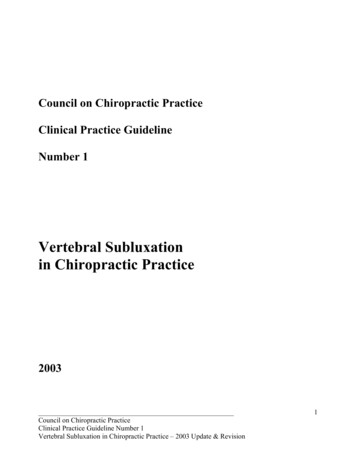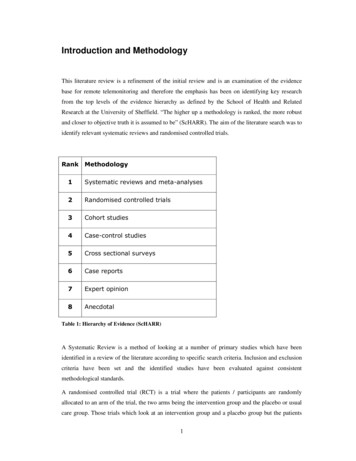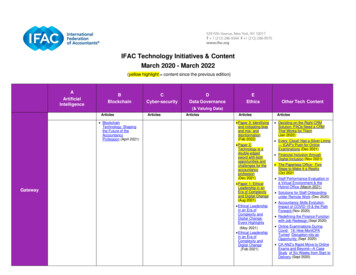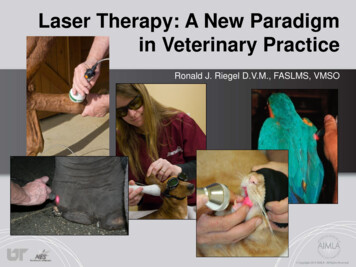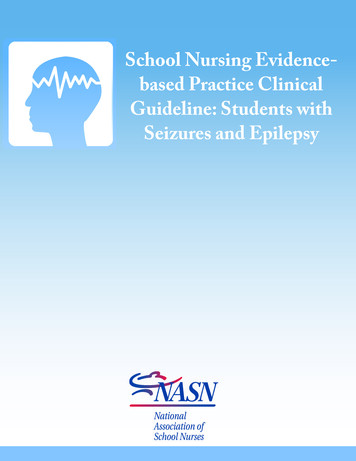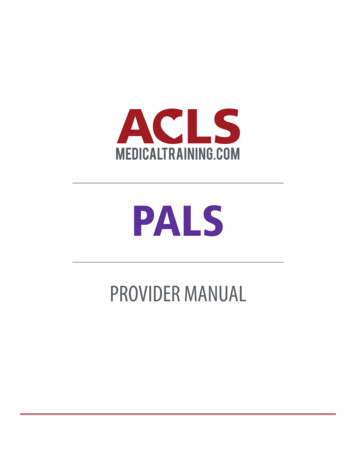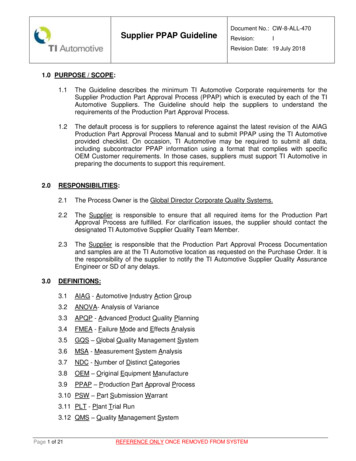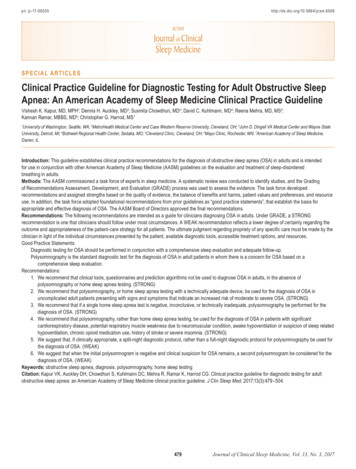
Transcription
pii: jc-17- 00035 http://dx.doi.org/10.5664/jcsm.6506S P E CIA L A R T IC L ESClinical Practice Guideline for Diagnostic Testing for Adult Obstructive SleepApnea: An American Academy of Sleep Medicine Clinical Practice GuidelineVishesh K. Kapur, MD, MPH1; Dennis H. Auckley, MD2; Susmita Chowdhuri, MD3; David C. Kuhlmann, MD4; Reena Mehra, MD, MS5;Kannan Ramar, MBBS, MD6; Christopher G. Harrod, MS7University of Washington, Seattle, WA; 2MetroHealth Medical Center and Case Western Reserve University, Cleveland, OH; 3John D. Dingell VA Medical Center and Wayne StateUniversity, Detroit, MI; 4Bothwell Regional Health Center, Sedalia, MO; 5Cleveland Clinic, Cleveland, OH; 6Mayo Clinic, Rochester, MN; 7American Academy of Sleep Medicine,Darien, IL1Introduction: This guideline establishes clinical practice recommendations for the diagnosis of obstructive sleep apnea (OSA) in adults and is intendedfor use in conjunction with other American Academy of Sleep Medicine (AASM) guidelines on the evaluation and treatment of sleep-disorderedbreathing in adults.Methods: The AASM commissioned a task force of experts in sleep medicine. A systematic review was conducted to identify studies, and the Gradingof Recommendations Assessment, Development, and Evaluation (GRADE) process was used to assess the evidence. The task force developedrecommendations and assigned strengths based on the quality of evidence, the balance of benefits and harms, patient values and preferences, and resourceuse. In addition, the task force adopted foundational recommendations from prior guidelines as “good practice statements”, that establish the basis forappropriate and effective diagnosis of OSA. The AASM Board of Directors approved the final recommendations.Recommendations: The following recommendations are intended as a guide for clinicians diagnosing OSA in adults. Under GRADE, a STRONGrecommendation is one that clinicians should follow under most circumstances. A WEAK recommendation reflects a lower degree of certainty regarding theoutcome and appropriateness of the patient-care strategy for all patients. The ultimate judgment regarding propriety of any specific care must be made by theclinician in light of the individual circumstances presented by the patient, available diagnostic tools, accessible treatment options, and resources.Good Practice Statements:Diagnostic testing for OSA should be performed in conjunction with a comprehensive sleep evaluation and adequate follow-up.Polysomnography is the standard diagnostic test for the diagnosis of OSA in adult patients in whom there is a concern for OSA based on acomprehensive sleep evaluation.Recommendations:1. We recommend that clinical tools, questionnaires and prediction algorithms not be used to diagnose OSA in adults, in the absence ofpolysomnography or home sleep apnea testing. (STRONG)2. We recommend that polysomnography, or home sleep apnea testing with a technically adequate device, be used for the diagnosis of OSA inuncomplicated adult patients presenting with signs and symptoms that indicate an increased risk of moderate to severe OSA. (STRONG)3. We recommend that if a single home sleep apnea test is negative, inconclusive, or technically inadequate, polysomnography be performed for thediagnosis of OSA. (STRONG)4. We recommend that polysomnography, rather than home sleep apnea testing, be used for the diagnosis of OSA in patients with significantcardiorespiratory disease, potential respiratory muscle weakness due to neuromuscular condition, awake hypoventilation or suspicion of sleep relatedhypoventilation, chronic opioid medication use, history of stroke or severe insomnia. (STRONG)5. We suggest that, if clinically appropriate, a split-night diagnostic protocol, rather than a full-night diagnostic protocol for polysomnography be used forthe diagnosis of OSA. (WEAK)6. We suggest that when the initial polysomnogram is negative and clinical suspicion for OSA remains, a second polysomnogram be considered for thediagnosis of OSA. (WEAK)Keywords: obstructive sleep apnea, diagnosis, polysomnography, home sleep testingCitation: Kapur VK, Auckley DH, Chowdhuri S, Kuhlmann DC, Mehra R, Ramar K, Harrod CG. Clinical practice guideline for diagnostic testing for adultobstructive sleep apnea: an American Academy of Sleep Medicine clinical practice guideline. J Clin Sleep Med. 2017;13(3):479–504.479Journal of Clinical Sleep Medicine, Vol. 13, No. 3, 2017
VK Kapur, DH Auckley, S Chowdhuri, et al. Clinical Practice Guideline: Diagnostic Testing OSAdisordered breathing during sleep. Individuals with OSA often feel unrested, fatigued, and sleepy during the daytime.They may suffer from impairments in vigilance, concentration, cognitive function, social interactions and quality oflife (QOL). These declines in daytime function can translate into higher rates of job-related and motor vehicle accidents.15 Patients with untreated OSA may be at increased riskof developing cardiovascular disease, including difficult-tocontrol blood pressure, coronary artery disease, congestiveheart failure, arrhythmias and stroke.16 OSA is also associated with metabolic dysregulation, affecting glucose controland risk for diabetes.17 Undiagnosed and untreated OSA is asignificant burden on the healthcare system, with increasedhealthcare utilization seen in those with untreated OSA,18highlighting the importance of early and accurate diagnosisof this common disorder.Recognizing and treating OSA is important for a numberof reasons. The treatment of OSA has been shown to improveQOL, lower the rates of motor vehicle accidents, and reducethe risk of the chronic health consequences of untreated OSAmentioned above.19 There are also data supporting a decreasein healthcare utilization and cost following the diagnosis andtreatment of OSA.20 However, there are challenges and uncertainties in making the diagnosis and a number of questions remain unanswered.Individuals with OSA can also have other sleep disordersthat may be related to or unrelated to OSA. Co-morbid insomnia has been found to be a frequent problem in patients withOSA.21 It is also possible that undiagnosed OSA may be masquerading as another sleep disorder, such as REM BehaviorDisorder.22 Therefore, when OSA is suspected, a comprehensive sleep evaluation is important to ensure appropriate diagnostic testing is performed to address OSA, as well as othercomorbid sleep complaints.The diagnosis of OSA involves measuring breathing during sleep. The evolution of measurement techniques anddefinitions of abnormalities justifies updating the guidelinesregarding diagnostic testing, but also complicates the evaluation and summary of evidence gathered from older researchstudies that have included diagnostic tests with diverse sensor types and scored respiratory events using different definitions. The third edition of the International Classificationof Sleep Disorders (ICSD-3) defines OSA as a PSG-determined obstructive respiratory disturbance index (RDI) 5events/h associated with the typical symptoms of OSA (e.g.,unrefreshing sleep, daytime sleepiness, fatigue or insomnia, awakening with a gasping or choking sensation, loudsnoring, or witnessed apneas), or an obstructive RDI 15events/h (even in the absence of symptoms).23 In additionto apneas and hypopneas that are included in the AHI, theRDI includes respiratory effort-related arousals (RERAs).The scoring of respiratory events is defined in The AASMManual for the Scoring of Sleep and Associated Events:Rules, Terminology and Technical Specifications, Version2.3 (AASM Scoring Manual).24 However, it should be notedthat there is variability in the definition of a hypopnea event.The AASM Scoring Manual recommended definition requires that changes in flow be associated with a 3% oxygenI N T RO D U C T I O NThe diagnosis of obstructive sleep apnea (OSA) was previously addressed in two American Academy of Sleep Medicine(AASM) guidelines, the “Practice Parameters for the Indications for Polysomnography and Related Procedures: An Updatefor 2005” and “Clinical Guidelines for the Use of UnattendedPortable Monitors in the Diagnosis of Obstructive Sleep Apneain Adult Patients (2007).” 1,2 The AASM commissioned a taskforce (TF) of content experts to develop an updated clinicalpractice guideline (CPG) on this topic. The objectives of thisCPG are to combine and update information from prior guideline documents regarding the diagnosis of OSA, including theoptimal circumstances under which attended in-laboratorypolysomnography (heretofore referred to as “polysomnography” or “PSG”) or home sleep apnea testing (HSAT) shouldbe performed.BACKG RO U N DThe term sleep-disordered breathing (SDB) encompassesa range of disorders, with most falling into the categories ofOSA, central sleep apnea (CSA) or sleep-related hypoventilation. This paper focuses on diagnostic issues related to thediagnosis of OSA, a breathing disorder characterized by narrowing of the upper airway that impairs normal ventilationduring sleep. Recent reviews on the evaluation and management of CSA and sleep-related hypoventilation have been published separately by the AASM.3–5The prevalence of OSA varies significantly based on thepopulation being studied and how OSA is defined (e.g., testingmethodology, scoring criteria used, and apnea-hypopnea index[AHI] threshold). The prevalence of OSA has been estimatedto be 14% of men and 5% of women, in a population-basedstudy utilizing an AHI cutoff of 5 events/h (hypopneas associated with 4% oxygen desaturations) combined with clinicalsymptoms to define OSA.6 OSA may impact a larger proportion of the population than indicated by these numbers, as thedefinition of AHI used in this study was restrictive and didnot consider hypopneas that disrupt sleep without oxygen desaturation. In addition, the estimate excludes individuals withan elevated AHI who do not have sleepiness but who maynevertheless be at risk for adverse consequences such as cardiovascular disease.7–10 In some populations, the prevalence ofOSA is substantially higher than this estimate, for example, inpatients being evaluated for bariatric surgery (estimated rangeof 70% to 80%)11 or in patients who have had a transient ischemic attack or stroke (estimated range of 60% to 70%).12 Otherdisease-specific populations found to have increased rates ofOSA include, but are not limited to, patients with coronaryartery disease, congestive heart failure, arrhythmias, refractory hypertension, type 2 diabetes, and polycystic ovariandisease.13,14The consequences of untreated OSA are wide ranging andare postulated to result from the fragmented sleep, intermittent hypoxia and hypercapnea, intrathoracic pressure swings,and increased sympathetic nervous activity that accompaniesJournal of Clinical Sleep Medicine, Vol. 13, No. 3, 2017480
VK Kapur, DH Auckley, S Chowdhuri, et al. Clinical Practice Guideline: Diagnostic Testing OSAdesaturation or a cortical arousal, but allows an alternativedefinition that requires association with a 4% oxygen desaturation without consideration of cortical arousals. Dependingon which definition is used, the AHI may be considerablydifferent in a given individual.25–27 The discrepancy betweenthese and other hypopnea definitions used in research studies introduces complexity in the evaluation of evidence regarding the diagnosis of OSA.Due to the high prevalence of OSA, there is significant costassociated with evaluating all patients suspected of havingOSA with PSG (currently considered the gold standard diagnostic test). Further, there also may be limited access to inlaboratory testing in some areas. HSAT, which has limitations,is an alternative method to diagnose OSA in adults, and may beless costly and more efficient in some populations. This guideline addresses some of these issues using an evidence-basedapproach.There are potential disadvantages to using HSAT, relative to PSG, because of the differences in the physiologicparameters being collected and the availability of personnelto adjust sensors when needed. The sensor technology usedby HSAT devices varies considerably by the number andtype of sensors that are utilized. Traditionally, sleep studieshave been categorized as Type I, Type II, Type III or TypeIV. Unattended studies fall into categories Type II throughType IV. Type II studies use the same monitoring sensors asfull PSGs (Type I) but are unattended, and thus can be performed outside of the sleep laboratory. Type III studies usedevices that measure limited cardiopulmonary parameters;two respiratory variables (e.g., effort to breathe, airflow),oxygen saturation, and a cardiac variable (e.g., heart rate orelectrocardiogram). Type IV studies utilize devices that measure only 1 or 2 parameters, typically oxygen saturation andheart rate, or in some cases, just air flow. This classification ofsleep study devices fails to consider new technologies, suchas peripheral arterial tonometry (PAT), and thus an alternative classification scheme has been proposed: the SCOPERclassification, which incorporates Sleep, Cardiovascular, Oximetry, Position, Effort and Respiratory parameters.28 TheSCOPER system allows for the inclusion of technologies suchas PAT. However, due to the complexity of the SCOPER classification, and lack of familiarity with it amongst practicingclinicians, the TF elected to refer to HSAT devices by thetraditional Type II through Type IV classification system, andto identify specific devices with technology outside of thisschema when appropriate. Regardless, as can be recognizedby both classifications, HSAT devices in comparison to attended studies raise risk for technical failures due to a lackof real-time monitoring, and have inherent limitations resulting from the inability of most devices to define sleep versuswake. Another potential disadvantage is that positive airwaypressure (PAP) cannot be initiated during a HSAT, but can beinitiated during a PSG if needed.Measurement error is inevitable in HSAT, compared againstPSG, as standard sleep staging channels are not typicallymonitored in HSAT (e.g., EEG, EOG and EMG monitoring arenot typically performed), which results in use of the recording time rather than sleep time to define the denominator ofthe respiratory event index (REI; the term used to representthe frequency of apneas and hypopneas derived from HSAT).HSAT devices that use conventional sensors are unable to detect hypopneas only associated with cortical arousals, whichare included in the recommended AHI scoring rule in theAASM Scoring Manual.24 Sensor dislodgement and poor quality signal during HSAT are additional contributors to the measurement error of the REI. All these factors can result in theunderestimation of the “true” AHI, and may result in the needfor repeated studies due to inadequate data for diagnosis.As a diagnostic guideline, our systematic review and recommendations incorporate evidence regarding the accuracy ofHSAT for diagnosing OSA. However, diagnosis occurs in thecontext of management of a patient within the healthcare system, and therefore, outcomes other than diagnostic accuracyare relevant in the evaluation of management strategies. Theseinclude the impact on clinical outcomes (e.g., sleepiness, QOL,morbidity, mortality, adherence to therapy) and efficiency ofcare (e.g., time to test, time to treatment, costs). Therefore,these outcomes are also considered in the formulation of thecurrent guideline.Prior AASM guidelines1,2 on the diagnosis of OSA includedstatements that the TF determined were no longer pertinent.Thus, these statements were not addressed in the current update. Moreover, prior guidelines included consensus statementsthat had not been specifically evaluated in clinical studies. Despite this limitation, two of these statements were adopted inthe current guideline as foundational statements that underpinthe provision of high quality care for the diagnosis of OSA (seegood practice statements). The scope of this guideline did notinclude a comprehensive update of technical specification fordiagnostic testing for OSA. Nevertheless, the TF consideredwhether currently recommended technology was used in theresearch studies that were evaluated. In particular, the TF determined that the use of currently AASM recommended flow(nasal pressure transducer and thermistor) and effort sensors(respiratory inductance plethysmography) during PSG andHSAT increased the value of evidence derived from validation studies.24 As part of the data extraction process, validationstudies were classified based on whether the currently recommended respiratory sensors were used for PSG or HSAT.METHODSExpert Task ForceThe AASM commissioned a TF of board-certified sleep medicine physicians, with expertise in the diagnosis and management of adults with OSA, to develop this guideline. The TFwas required to disclose all potential conflicts of interest (COI)according to the AASM’s COI policy, both prior to being appointed to the TF, and throughout the research and writing ofthis paper. In accordance with the AASM’s conflicts of interestpolicy, TF members with a Level 1 conflict were not allowed toparticipate. TF members with a Level 2 conflict were requiredto recuse themselves from any related discussion or writingresponsibilities. All relevant conflicts of interest are listed inthe Disclosures section.481Journal of Clinical Sleep Medicine, Vol. 13, No. 3, 2017
VK Kapur, DH Auckley, S Chowdhuri, et al. Clinical Practice Guideline: Diagnostic Testing OSATable 1—PICO questions.1. In adult patients with suspected OSA, do clinical prediction algorithms accurately identify patients with a high pretest probability for OSA compared tohistory and physical exam? (See Recommendation 1)2. In adult patients with suspected OSA, does HSAT accurately diagnose OSA, improve clinical outcomes and improve efficiency of care compared toPSG? (See Recommendation 2 & 3)3. In adult patients undergoing HSAT for suspected OSA, is there a minimum number of hours of HSAT that accurately diagnoses OSA and improvesefficiency of care? (See Recommendation 2 & 3)4. In adult patients undergoing HSAT for suspected OSA, do multiple nights of HSAT accurately diagnose OSA and improve efficiency of carecompared to a single night of HSAT? (See Recommendation 2 & 3)5. In adult patients with comorbid conditions (poststroke, chronic heart failure, chronic obstructive pulmonary disease, opioid use, neuromusculardisease, hypoventilation, insomnia) and suspected OSA, does HSAT accurately diagnose OSA, improve clinical outcomes and efficiency of carecompared to PSG? (See Recommendation 4)6. In adult patients undergoing PSG for suspected OSA, does a split-night study accurately diagnose OSA and improve efficiency of care compared toa full-night study? (See Recommendation 5)7. In adult patients undergoing PSG for suspected OSA, do two nights of PSG accurately diagnose OSA and improve efficiency of care compared to asingle night of PSG? (See Recommendation 6)8. In adult patients with diagnosed OSA, does repeat PSG or HSAT to confirm severity of OSA or efficacy of therapy improve outcomes relative toclinical follow-up without repeat testing? (No recommendations, see Future Directions)9. In adult patients scheduled for upper airway surgery for snoring or OSA, does PSG or HSAT accurately identify patients with OSA and improveclinical outcomes compared to using a history and physical exam or clinical prediction algorithms? (No recommendations, see Future Directions)Table 2—“Critical” outcomes by PICO.PICO Question123456789DiagnosticAccuracy* FN only SubjectiveSleepinessQuality of Life**CPAPAdherenceAHIDepression CardiovascularEndpoints * diagnostic accuracy is determined by the number of true positive (TP), false positive (FP), true negative (TN), false negative (FN) diagnoses. ** basedon Sleep Apnea Quality of Life Index (SAQLI) and Functional Outcomes of Sleep Questionnaire (FOSQ) measures of QOL. 36-Item Short Form SurveyInstrument (SF-36) measure of QOL was determined to be important but not critical for decision-making based on TF consensus.Table 3—Summary of clinical significance thresholds forclinical outcome measures.Outcome MeasureEpworth Sleepiness Score (ESS)Clinical SignificanceThreshold2 pointsFunctional Outcomes of Sleep Questionnaire(FOSQ)1 pointSleep Apnea QOL Index (SAQLI)1 pointCPAP Adherence (h/night)CPAP Adherence (% nights 4 h)SF-36 (Vitality Score)PICO questions were developed based on a review of the existing AASM practice parameters on indications for use ofPSG and HSAT for the diagnosis of patients with OSA, and areview of systematic reviews, meta-analyses, and guidelinespublished since 2004. The AASM Board of Directors (BOD)approved the final list of PICO questions presented in Table 1before the literature search was performed. The PICO questions identify the commonly used approaches and devices forthe diagnosis of OSA. Based on their expertise, the TF developed a list of patient-oriented clinically relevant outcomes thatare indicative of whether a treatment should be recommendedfor clinical practice. A summary of the critical outcomes foreach PICO is presented in Table 2. Lastly, clinical significance thresholds, used to determine if a change in an outcomewas clinically significant, were defined for each outcome byTF clinical judgment, prior to statistical analysis. The clinicalsignificance thresholds are presented by outcome in Table 3.It should be noted that there was insufficient evidence to directly address PICO question 1, as no studies were identifiedthat compared the efficacy of clinical prediction algorithmsto history and physical exam. However, the TF decided to0.5 h/night10%12.5 pointsSF-36 (Physical Component Summary Score)3 pointsSF-36 (Mental Component Summary Score)3 pointsPICO QuestionsA PICO (Patient, Population or Prob lem, Intervention, Comparison, and Outcomes) question template was used to develop clinical questions to be addressed in this guideline.Journal of Clinical Sleep Medicine, Vol. 13, No. 3, 2017482
VK Kapur, DH Auckley, S Chowdhuri, et al. Clinical Practice Guideline: Diagnostic Testing OSAFigure 1—Evidence base flow diagram.terms and keywords as presented in the supplemental material. The Embase database was searched from January 1, 2005through September 13, 2012. These searches yielded a total of3,937 articles. There were 205 duplicates identified resulting ina total of 3,732 articles from both databases.A second round of literature searches was performed inPubMed and Embase to capture more recent literature. ThePubMed database was searched from July 27, 2012 to December 23, 2013, and the Embase database was searched from September 13, 2012 to December 23, 2013. These searches yieldeda total of 2,061 articles. There were 670 duplicates identifiedresulting in 1,391 additional papers from both databases.A final literature search was performed in PubMed to capture the latest literature. The PubMed database was searchedfrom December 24, 2013 to June 29, 2016 and identified 2,129articles.Based on their expertise and familiarity with the literature, TF members submitted additional relevant literature andscreened reference lists to identify articles of potential interest.This served as a “spot check” for the literature searches to ensure that important articles were not overlooked and identifiedan additional 140 publications.A total of 7,392 abstracts were assessed by two reviewers todeter mine whether they met inclusion criteria presented in thesupplemental material. Articles were excluded per the criteriacompare the efficacy of clinical prediction algorithms to PSGand HSAT.Literature Searches, Evidence Review and DataExtractionThe TF performed a systematic review of the scientific literature to identify articles that addressed at least one of the ninePICO questions. Multiple literature searches were performedby AASM staff using the PubMed and Embase databases,throughout the guideline development process (see Figure 1).The search yielded articles with various study designs, however the analysis was limited to randomized controlled trials (RCTs) and observational studies. The articles that werecited in the 2007 AASM clinical practice guideline,2 2005practice parameter,1 2003 review,29 and 1997 review30 were included for data analysis if they met the study inclusion criteriadescribed below.The literature searches in PubMed were conducted using acombination of MeSH terms and keywords as presented in thesupplemental material. The PubMed database was searchedfrom January 1, 2005 through July 26, 2012 for any relevant literature published since the last guideline. The PubMed searchwas expanded on September 26, 2012 to identify relevant articles published prior to January 1, 2005. Literature searchesalso were also performed in Embase using a combination of483Journal of Clinical Sleep Medicine, Vol. 13, No. 3, 2017
VK Kapur, DH Auckley, S Chowdhuri, et al. Clinical Practice Guideline: Diagnostic Testing OSAthe downstream consequences of an accurate diagnosis versusan inaccurate diagnosis (see supplemental material, Table S1),and used the estimates to weigh the benefits of an accuratediagnosis versus the harms of an inaccurate diagnosis. Thisinformation was used, in part, to assess whether a given diagnostic approach could be recommended when comparedagainst PSG.For clinical outcomes of interest, data on change scores wereentered into the Review Manager 5.3 software to derive themean difference and standard deviation between the experimental diagnostic approach and the gold standard or comparator. For studies that did not report change scores, data fromposttreatment values taken from the last treatment time-pointwere used for meta-analysis. All meta-analyses of clinical outcomes were performed using the random effects model withresults displayed as a forest plot. There was insufficient evidence to perform meta-analyses for PICOs 3 and 9, thus norecommendations are provided.Interpretation of clinical significance for the clinical outcomes of interest was conducted by comparing the absolute effects to the clinical significance threshold previously determinedby the TF for each clinical outcome of interest (see Table 3).Table 4—Summary of prevalence estimates for highrisk and low risk adult sleep clinic patients with OSA bydiagnostic cutoff.Diagnostic CutoffAHI 5AHI 15AHI %25%10%listed in the supplemental material and Figure 1. A total of 98articles were included in evidence base for recommendations. Atotal of 86 studies were included in meta-analysis and/or grading.Meta-AnalysisMeta-analysis was performed on both diagnostic and clinicaloutcomes of interest for each PICO question, when possible.Outcomes data for diagnostic approaches were categorizedas follows: clinical tools, questionnaires, and prediction algorithms; history and physical exam; HSAT; attended PSG;split-night attended PSG; two-night attended PSG; singlenight HSAT; multiple-night HSAT; follow-up attended PSG;and follow-up HSAT. The type of HSAT devices identified inliterature search included type 2; type 3; 2–3 channel; singlechannel; oximetry; and PAT. A definition of these devices hasbeen previously described.31 Adult patients were categorized asfollows: suspected OSA; suspected OSA with comorbid conditions; diagnosed OSA; and scheduled for upper airway surgery.For diagnostic outcomes, the pretest probability for OSA(i.e., the prevalence within the study population), sensitivity andspecificity of the tested diagnostic approach, and number of patients for each study was used to derive two-by-two tables (i.e.,the number of true positive (TP), true negative (TN), false positive (FP), and false negative (FN) diagnoses per 1,000 patients)in both high risk and low risk patients, for each OSA severitythreshold (i.e., AHI 5, AHI 15, AHI 30). For analyses thatincluded five or more studies, pooled estimates of sensitivity,specificity, and accuracy were calculated using hierarchical random effects modeling performed in STATA software (accuracywas derived by HSROC curves). When analyses included fewerthan five studies, ranges of sensitivity, specificity and accuracywere used. Based on their clinical expertise and a review of available literature, the TF established estimates of OSA prevalenceamong “low risk” and “high risk” patients for each OSA severity threshold. The TF envisioned a sleep clinic cohort of middleaged obese men with typical symptoms of OSA as an example ofa high-risk patient population. In contrast, a sleep clinic cohortof younger non-obese women with possible OSA symptoms wasused as prototype for a low risk patient population. Prevalenceestimates for these populations are presented in Table 4.The sensitivity and specificity of included studies wereentered into Review Manager 5.3 software to generate forestplots for each analysis. The estimates of sensitivity and specificity (pooled or ranges), and OSA prevalence were enteredinto the GRADE (Grading of Recommendations Assessment,Development and Evaluation) Guideline Development Tool(GDT) to generate the two-by-two tables. The TF determinedJournal of Clinical Sleep Medicine, Vol. 13, No. 3, 2017Strength of RecommendationsThe assessment of evidence quality was performed accordingto the GRADE process.32 The TF assessed the following fourcomponents to determine the direction and strength of a recommendation: quality of evidence, balance of beneficial andharmful effects, patient values and preferences and resourceuse as described below.1. Quality of evidence: based on an assessment ofthe overall risk of bias (randomization, blinding,allocation concealment, selective reporting, andauthor disclosures), imprecision (clinical significancethresholds), inconsistency (I2 cutoff of 75%),indirectness (study population), and risk of publicationbias (fund
479 Journal of Clinical Sleep Medicine, Vol. 13, No. 3, 2017 Introduction: This guideline establishes clinical practice recommendations for the diagnosis of obstructive sleep apnea (OSA) in adults and is intended for use in conjunction with other American Academy of Sleep Medicine (AASM) guidelines on the evaluation and treatment of sleep-disordered



